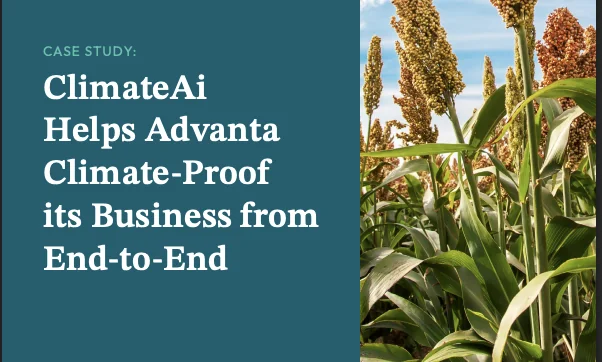Zoom Webinar with Live Q&A on Oct 8th, 9:00 AM PT — Introducing AI Agents, Turn Climate Data Into Actions With One Prompt → Register Here
Andy Paterson • August 15th, 2025.
As climate change makes the supply of agricultural commodities harder to predict, food and beverage procurement leaders face price volatility. To ensure their supply chains and suppliers are better adapted to the changes a warming climate brings, weather intelligence will be a critical tool to ensure they have effective adaptation strategies.
Coupled with tariffs and inflation, the growing supply and price volatility in food and beverage supply chains caused by climate change is making it increasingly difficult to keep costs where customers expect them to be. Companies can do little about tariffs and inflation, but they can understand their exposure to climate risks and build resilience through weather intelligence.
This article will look at what weather intelligence is and give five reasons why it is playing an increasingly important role in reducing supply chain disruptions for food and beverage procurement leaders.
Weather Intelligence is the next iteration of weather forecasting. It provides organizations with accurate, granular, and timely information that helps them mitigate risks and capitalize on opportunities.
There have been daily accurate forecasts that can tell people to bring an umbrella when it rains or sunscreen when it’s hot for a while. However, those short-term, sometimes inaccurate forecasts are not suitable for making long-term strategic decisions or understanding how predicted weather patterns in the upcoming season will impact plant growth stages and yields.
Weather intelligence uses advanced weather data collection and analysis models to measure short and long-term weather patterns accurately. It also takes data on how certain climate events impact specific assets, like crops, real estate, and infrastructure, to determine how they might affect a building, road, or, in the case of crops, yields on a field-by-field basis.
As the global climate becomes more erratic and unpredictable, food and beverage procurement decisions based on historical experience and traditional weather forecasts will be less effective.
Weather intelligence provides food and beverage procurement leaders with the critical data needed to ensure supply continuity, stable pricing, and build long-term resilience.
These are the five ways food and beverage companies will benefit from weather intelligence:
The Challenge:
Growers face short-term risks, both day to day and season to season. However, with growers and the food and beverage companies facing so many risks, it can be difficult to cut through the noise and prioritize the risks that will have the greatest impact.
These risks have such a huge range, from short-term temperature and precipitation change to crops being no longer viable in certain regions over the longer term. Knowing where to focus is critical for supply chain planning and capital and resource allocation.
The Solution:
AI-driven weather intelligence climate models, like ClimateAi’s, identify the most likely climate risks (heatwaves, drought, frost, water stress, disease pressure, etc.) for a given crop, region, or supplier over 5–40 years. These insights are translated into practical playbooks, clear, crop and region-specific recommendations for adapting to those risks.
This improves the long-term resilience for both growers and sourcers:
Solution in Action:

Leading Australian seed company Advanta Seeds faced 30–50% annual revenue volatility due to climate-driven variability in seed production. Using ClimateAi’s ClimateLens platform, Advanta:
The Challenge:
Weather conditions can vary dramatically across short distances, even within a single growing region, where microclimates can bring increased precipitation or temperatures on a field-to-field scale. Without hyper-local data, procurement teams risk overgeneralizing and missing key climate risks or opportunities that affect crop quality, yield, or logistics at the field level.
The Solution
By analyzing the best weather data collection instruments and utilizing predictive modeling, weather intelligence enables growers and food and beverage sourcers to understand what is happening at a 1km resolution for temperature and solar radiation, and at a 25km resolution for precipitation forecasts.
This level of granularity means a better understanding of how each type of weather risk will impact crops, resulting in better allocation of resources and yields.
The Challenge:
Relying on growing calendars, which use a generic number of days to estimate sowing to harvest and each phenological stage in between (flowering, fruiting, etc.) to plan harvests and processing schedules, often leads to mismatches between when crops should be ready and when they are.
Climate change is causing growing conditions to diverge significantly from their estimated harvest time across regions and even from field to field. It is also impacting the instances of pests and disease. This variability complicates everything from pest control application to harvest logistics and quality control.
The Solution:

Using high localized, crop-specific Growing degree days (GDD) – a unit of measurement used to accurately track plant growth and the instances of potential pests and diseases- is the best way to optimize planning.
With GDD, growers can determine the optimal harvest time for their crop and set up logistics accordingly. Additionally, F&B procurement leaders will know how much crop to expect from suppliers, enabling them to optimize operations and logistics.
The Challenge:
A cookie-cutter approach for every crop will no longer be practical. Each crop and variety of crop that food and beverage sourcers rely on has very specific needs. Crops face different weather sensitivities at different stages of growth. A dry spell during flowering is far more damaging than during maturation. Without visibility into phenology-specific risks, sourcers cannot effectively time purchases, contracts, or contingency plans.
The Solution:
With weather intelligence, crop stage-specific monitoring models, and the integration of real-time weather risks and GDD data, growers and sourcers get AI-driven alerts for critical development windows. Providing them with early warnings on stage-specific risks tailored to specific crop stages and geographies, along with reliable quality and yield predictions.
The Challenge:
Climate change is shifting the geographic viability of crop production. Traditional sourcing regions may become less reliable, while new regions may emerge as future supply hubs. But identifying these “climate analogs,” areas that will resemble today’s traditional growing zones in the future, is difficult without precise, long-term data.
The Solution:
AI-driven climate analog modeling allows procurement teams to see which regions will offer optimal growing environments in the years ahead. By integrating temperature, precipitation, soil moisture, and Growing Degree Day (GDD) trends, the tool creates a precise picture of how production viability will shift over time.
Research shows that viable growing regions could expand 1,200 KM north in the US by the end of this century due to climate change. Climate analog analyses enable complete customization for specific crops and different time horizons, allowing you to find exactly which regions will be perfectly suited for your crop in 10, 20, or 50 years.
Integration of weather intelligence into long and short-term procurement strategies is already an enabler for food and beverage procurement leaders to optimize their supply chains.
As climate change increases, climate volatility reduces crop yields and pushes up prices, reducing risks through advanced planning will be critical. Here is how ClimateAi can help at each stage of the process
👉Schedule a demo to see how ClimateAi’s weather intelligence can strengthen your procurement strategy.

Andy Paterson is a content creator and strategist at ClimateAi. Before joining the team, he was a content leader at various climate and sustainability start-ups and enterprises.
Andy has held writing, content strategy, and editing roles at BCG, Persefoni, and Good.Lab. He has helped build one of the industry’s most popular newsletters and regularly publishes environmental science articles with Research Publishing.